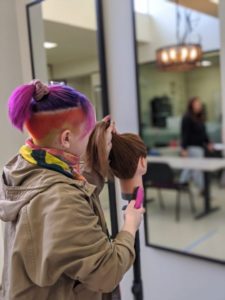Going green and being conscious about environmental issues doesn’t have to mean pedalling for power or cutting hair in the dark. Non-renewable fossil fuels (crude oil, natural gas, coal, oil shales) currently supply Australia with more than 95 percent of our energy needs. Potentially, all the equipment that you run in a hairdressing salon, beauty clinic or florist shop is powered by non-renewable fossil fuels. Non-renewable energy is energy produced by burning fossil fuels, such as coal. They are non-renewable because there are finite resources, meaning that if they are continually used, one day they will run out. Whether you are an employer or apprentice sustainability is becoming more of an issue in hairdressing, beauty and floristry workplaces.
Burning fossil fuels contributes to increased levels of carbon dioxide in the atmosphere and to global climate change.
Today’s hairdressing salons, beauty clinic or florist shop often have a range of services that can affect the environment in many ways. Some hairdressing salons or beauty clinics you may work in during your career offer beauty services. These may include nail and skin treatments, such as tanning, facials, body wraps, manicures, and make-up applications, as well as many retailing many products. In providing these services, however, many wastes can be generated. The most notable environmental issues for salons are:
- The use of chemical products (dyes, bleaches, solvents)
- Air pollution (odours)
- Water use and wastewater disposal
- Energy use
- Solid Waste (Paper towels, product containers, other packaging)
Australia has hundreds of thousands of hairdressing salons and beauty clinics, some located in private homes. Although individual businesses may not discharge substantial amounts of wastes, the main problem is the combined impact of chemical and waste discharges from many small businesses. A hairdresser’s day-to-day decisions regarding wastes can make a large impact on environmental issues. By implementing some basic environmental practices, salons can increase their facilities’ environmental responsibility, and often lower many costs.
There are a wide range of chemicals used in the hair and beauty industry. Many of these chemicals are hazardous to the environment, but are also of concern to human health.
|
Chemicals in hair salons |
||
| hair dyes | straighteners | bleaches |
| shampoos | peroxides | brow and lash tints |
| hair styling agents | permanent wave solutions | disinfectants and cleaning products |
Did you know?
One study in the United States of America has shown that up to 20% of hairdressers leave the business because of allergies or dermatitis.
Did you know?
If a tap drips once every second, 10,000 litres of water are wasted in one year!!
What Can I do as a hairdressing apprentice, beauty trainee or floristry apprentice (Hairdressing Sustainability)?
- Don’t leave lights on when there is no one in the salon.
- Make sure you are using energy-efficient bulbs and not old-fashioned low-efficiency fluorescent tubes. Energy efficient bulbs might seem more expensive to buy, but they last longer and waste less energy.
- There is no need to leave any equipment on standby. It’s far more economical to turn appliances off at the power point. If you have a photocopier, computers or televisions that aren’t being constantly used, turn them off each time you have finished using them.
- Don’t forget – screen savers do not save electricity they simply protect the screen. Leaving a photocopier on overnight uses enough energy to print more than 5,000 A4 copies.
- If you lower the temperature in your hairdressing salon building by 1°C you can cut your heating bills by almost 10%. It’s best to set your thermostats to between 16°C and 19°C.
- Check your water heater thermostat and make sure it’s at the right temperature. You shouldn’t have to add cold water to hot water to make it the right temperature. Instead, turn your thermostat down.
- Lighting will account for a large proportion of your electricity bills, so make sure your windows are kept clean to ensure your salon gets as much natural light as possible.
- If there are areas of the salon that aren’t in constant use, you could fit a sensor light that will only operate when someone enters the area and switch off when there is no further movement.
- It is also worth regularly servicing your heating system. Costs can increase by about 30% if the system is poorly maintained. Close windows when the heating is on and don’t heat unused rooms.
- How you launder your towels will have a major impact on the environment. You may be able to switch to cold water with newer washing machines.
- If you need to update your hot water service then consider buying an efficient system. Up to 90% of the energy used for providing hot water can be wasted because of heat loss and system inefficiencies.
























